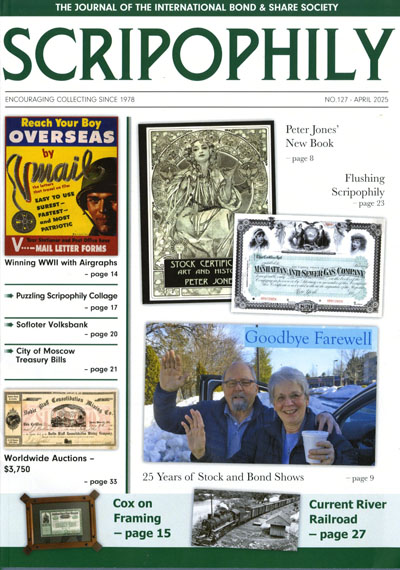
This article appeared in
SCRIPOPHILY
April, 2025
Scripophily is a member benefit of
the International Bond & Share Society.
Visit the IBSS website for info.
Framing Certificates – Is that really a good idea?
Back when I was in the coal business analyzing properties for purchase, I spent countless hours discussing various factors over which we had minimal control. Ambiguity was the rule. We had to make decisions knowing full well that practically everything affecting profits was going to change over time.
The decisions we make in collecting are similar, although at dramatically lower and more personal levels. Like in business, time and large bank accounts can often soften the effects of poor decisions. The opposite can also be true.
As a cataloger, I get to witness all sorts of hobby decisions; some good and some not. I’ve already talked in earlier columns about the downsides of donating collections. I’ll probably cover donations again, but this time I want to talk about framing.
With admittedly making a wild guess, I feel that many of us in the hobby would like to display certificates on our walls. Speaking strictly for myself, my desire to display any collectible is for my enjoyment, not really anyone else.
But here’s the rub. Framing is often a poor decision for collectibles like ours. At the decided risk of offence, I warn that the more expensive and rare the displayed certificate, the worse the decision. I suspect most advanced collectors know all about the downsides of framing, but I’ll remind everyone here, as much for myself as for my readers.
First, ultraviolet radiation in both direct and reflected sunlight deteriorates colors and ages paper. Most mats used in framing are acidic to greater or lesser degrees. Generally speaking, and never minding the labeling, the cheaper the mat, the more acidic. Framers use tape and hinges to fasten certificates in place and many adhesives used in those products are hard or impossible to reverse without paper damage.
Having said that, I know with certainty that most advanced collectors can readily repeat every time-worn mantra of paper preservation. “Keep good paper away from bad.” “Acid migrates from poor paper to good.” Use only archival holders and storage containers.” “Use ‘acid-free’ mats for framing.” “Use museum (UV) glass for framing.” Etc. Etc. Let’s not forget, “Use a conservation framer.”
So why do so many collectors violate most or all these rules? Cost! None of the suggestions are cheap. Professional framers have sometimes overstated their skills. Manufacturers have been known to shade the truth about their “archival materials.”
The liabilities for framing certificates may not be known for years, possibly never by the collectors who originally framed them. Rest assured, however, that someone at some point will remove certificates from frames. That is when those future collectors will discover the effects of acidic deterioration from mats. Generic certificates printed on non-rag paper are the hands-down worst for framing. Because of extended exposure to both sunlight and acidic mats, some become as brittle and as delicate as dried leaves.
For several years, I have been keeping records of framed certificates as I catalog. I wish I had started sooner and I wish I were 100% consistent. Nonetheless, I just counted 122 certificates that had been sold as framed. One framed example encountered yesterday was a previously unknown bond that had sold on eBay for $145. I recorded yet another framed certificate today, although it was a cheapie and thankfully unissued.
In terms of collectible value, a full third of the framed certificates I’ve cataloged sold for less than $50.
Unfortunately, the top third had an average retail value of $1,240. Whoever framed those certificates are the collectors I want to reach! Sadly, I am willing to wager that most of them will never read this article. I am probably not at risk of stepping on their toes to suggest anyone spending that kind of money on collectible certificates ought to be able to afford genuine conservation-grade framing.
Several of the framed and cataloged certificates in my database are those autographed by celebrities, the two most common being J. P. Morgan and Jay Gould. Those certificates are thankfully considered common in our hobby. Still, I hate to see any of them behind glass. After all, both Morgan and Gould stopped signing certificates over a century ago.
Realistically, I wonder whether it makes any sense to frame certificates at all when practically no one is going to appreciate them as much as us. Having displayed certificates in my office for years, I can testify that the numbers of stifled yawns suggest large numbers of people are either not interested or suffer from sleep deprivation.
If our certificates are unlikely to impress anyone other than ourselves, what is the reason for sacrificing good certificates to framing? Why not FRAME COPIES? After all, famous museums have been displaying copies and facsimiles for years. Why not us? Consider an that appeared in the Washington Post Magazine titled, "The Imitation Game: Some of the most beloved objects in Washington museums are not as authentic as visitors might assume." (Feb. 27, 2019.)
My suggestion is simple. Take desired item(s) to professionals who can scan at high resolutions with good color accuracy. Then have someone print one or more copies on decent rag paper. Finally, frame and display the copy for personal enjoyment. Tell the framer that you plan on occasionally replacing your sacrificial facsimile with a fresh copy. If a certificate is signed on the back by a celebrity, you have the luxury of illustrating a copy of that autograph alongside its host certificate without needing a special frame. By framing good reproductions, you will even give yourself the capability of replacing certificates over time with different certificates and different mats.